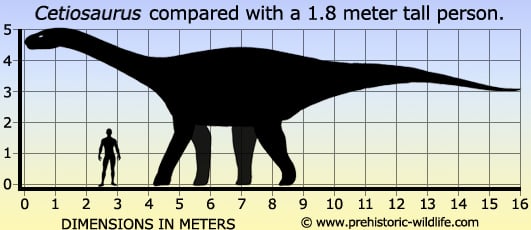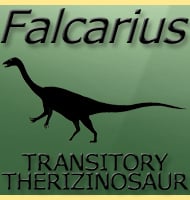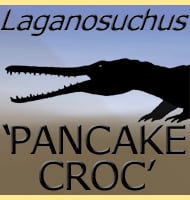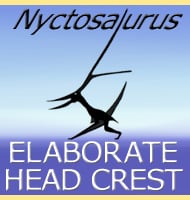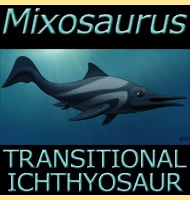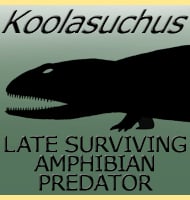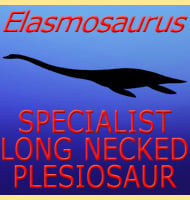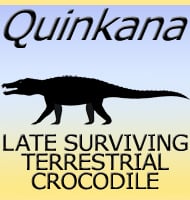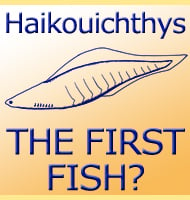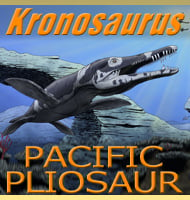In Depth
One of the most common European sauropods of the Jurassic, Cetiosaurus is actually one of the most primitive. In more advanced sauropods the vertebrae are hollow as a weight saving feature, however Cetiosaurus has solid vertebrae which hint at its basal position in the evolution of sauropods. These solid vertebrae are similar to those of advanced whales that have solid vertebrae so that their spines can withstand the crushing pressures associated with very deep water. In a complete contrast to sauropod evolution, the primitive whale forms such as Basilosaurus had hollow vertebrae which are why they are thought to have roamed the upper depths.
Returning back to sauropods, Cetiosaurus seems to have had a distribution that covered most of Western Europe all the way down to North Africa. At sixteen meters long Cetiosaurus was a small to medium sized sauropod, but as a mid-Jurassic genera go it was a giant, with larger sauropod dinosaurs such as Diplodocus and Brachiosaurus not appearing until the very last stages of the Jurassic. Despite the size however, Cetiosaurus could have been potential prey for large mid Jurassic theropods such as Megalosaurus and Dubreuillosaurus.
Cetiosaurus is the type genus of the Cetiosauridae, and currently Cetiosaurus is thought to be related to Patagosaurus and Barapasaurus.
Further Reading
– A description of a portion of the skeleton of the Cetiosaurus, a gigantic extinct saurian reptile occurring in the oolitic formations of different portions of England. – Proceedings of the Geological Society of London 3: 457–462. – Richard Owen – 1841. – Monograph of the Mesozoic Reptilia, part 2: Monograph on the genus Cetiosaurus. – Palaeontolographical Society Monograph, 29: 27–43. – Richard Owen – 1875. – On parts of skeleton of Cetiosaurus leedsi, a sauropodous dinosaur from the Oxford Clay of Peterborough. – Proceedings of the Zoological Society of London 1: 232–243 – A. S. Woodward – 1905. – The Rutland Cetiosaurus: the anatomy and relationships of a Middle Jurassic British sauropod dinosaur. – Palaeontology 45 (6): 1049–1074. – P. Upchurch & J. Martin – 2002. – The Anatomy and Taxonomy of Cetiosaurus (Saurischia, Sauropoda) from the Middle Jurassic of England. – Journal of Vertebrate Palaeontology 23 (1): 208–231. – P. Upchurch & J. Martin – 2003. – Case 3472: Cetiosaurus Owen, 1841 (Dinosauria, Sauropoda): proposed conservation of usage by designation of Cetiosaurus oxoniensis Phillips, 1871 as the type species. – Bulletin of Zoological Nomenclature 66 (1): 51–55. – P. Upchurch, J. Martin & M. Taylor – 2009. – The sauropod dinosaur Cetiosaurus OWEN in the Bathonian (Middle Jurassic) of the Ardennes (NE France): insular, but not dwarf [Le sauropode dinosaurien Cetiosaurus OWEN dans le Bathonien (Jurassique Moyen) des Ardennes (NE France) : insulaire, mais pas nain]. – Carnets de G�ologie, 2011: 149–161 – E. Buffetaut, B. Gibout, I. Launois & C. Delacroix – 2011. – OPINION 2331 (Case 3472): Cetiosaurus Owen, 1841 (Dinosauria, Sauropoda): usage conserved by designation of Cetiosaurus oxoniensis Phillips, 1871 as the type species. – Bulletin of Zoological Nomenclature 71(1): 48-50 – International Commission on Zoological Nomenclature – 2014.
